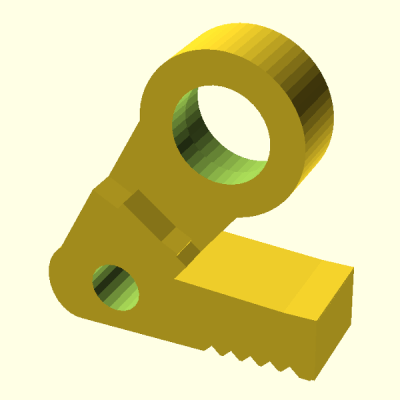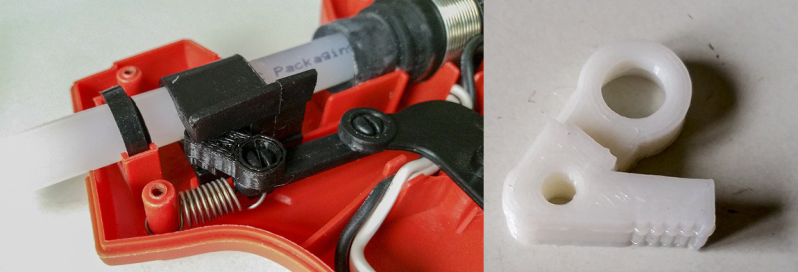Picture this: you need to buy a simple tool like a glue gun. There’s usually not a whole lot going on in that particular piece of technology, so you base your decision on the power rating and whether it looks like it will last. And it does last, at least for a few years—just long enough to grow attached to it and get upset when it breaks. Sound familiar?
 [pixelk] bought a glue gun a few years ago for its power rating and its claims of strength. Lo and behold, the trigger mechanism has proven to be weak around the screws. The part that pushes the glue stick into the hot end snapped in two.
[pixelk] bought a glue gun a few years ago for its power rating and its claims of strength. Lo and behold, the trigger mechanism has proven to be weak around the screws. The part that pushes the glue stick into the hot end snapped in two.
It didn’t take much to create a replacement. [pixelk] got most of the measurements with calipers and then got to work in OpenSCAD. After printing a few iterations, it fit well enough, but [pixelk] saw a chance to improve on the original design and added a few teeth where the part touches the glue stick. The new part has been going strong for three months.
We think this entry into our Repairs You Can Print contest is a perfect example of the everyday utility of 3D printers. Small reproducible plastic parts are all around us, just waiting to fail. The ability to not only replace them but to improve on them is one of the brightest sides of our increasingly disposable culture.
Still haven’t found a glue gun you can stick to? Try building your own.















Never knew I could print things like this. Time to make a brand new glue gun I guess :)
Ben Heck would likely disagree, he now has a multi-part series about making a glue-gun from scratch.
Cost-effective is not what hacking is always about.
Buying new vs. repairing old, an old question. I wonder what will humans do in space before we invent replicators……
Time spent to disparage the ways that other people spend their free time…
Big fan of repairing stuff using a 3dprinter.
One question to the people who are using OpenSCAD:
How does it compare to other CAD software? Like Catia or Solidworks?
I know that with OpenSCAD, you have to program your part, which helps a lot for making a parametric designed part, but how fast can you be to make a “complicated part?
The one that is presented is quite simple, but in a “traditional CAD software”, I guess it would take 5-10 min, is it longer with OpenSCAD?
I really like the fact that OpenSCAD is a free software, I should download it to try it out, but I would like to know if it’s really worth to spend a lot of time in learning it?
(BTW nice repair that you did!)
Open SCAD will never and I suspect was never intended to compete with Catia, Solidworks, Fusion360 or Onshape for modelling complex parts. For example there is no command for fillet, loft, sweep, drafted extrusion, etc. OpenSCAD.
OpenSCAD is great for making simple parts made up of simple geometry like circles, rectangles and polygons. Once complexity hits a certain level it becomes cumbersome. Download the hot glue gun trigger file and read the code in a text editor, it isn’t too many lines but it isn’t particularly intuitive how to edit the design (partly because it isn’t commented much). Find a larger more complex object and look at the code for that, it gets out of hand pretty quickly.
I’m not quite experienced enough in the various CAD packages give you a good answer about time comparisons and stuff like that but I can tell you this. If you want an idea of how powerful OpenScad can be I would suggest checking out the Mendel90. It’s an open source 3d printer design that exists as a combination of openscad and python scripts.
The cool thing is that you don’t just download the design and start building. Simply by making easy edits to some simple text files you can change the size of the printer, change what kinds of parts are used to better take advantage of what you already have or what is available to you, etc… Then you run a make script. It pops out all the STLs you need to print for your custom version. It generates cutting and drilling templates for the sheet parts. It even can create an stl of the whole printer which you can use to see how the parts are supposed to fit together as you are building.
And of course, since this whole thing exists as source code it is kept in git hub. You can view the history and even create your own branch.
I don’t know if you are interested in building a printer or not but just looking at how this works you can get an idea of just how powerful of a tool OpenScad can be. If you have time you might watch this video where the customization process is described. https://youtu.be/EsZt69n5SDU
even the current prusa i3 mk2 has a bunch of OpenSCAD parts.
If you want more complex parts, it’s just a matter of a little bit of math, or a lot of math. I’ve done supershape, and bezier, and all manner of other things in OpenSCAD. There’s even a nurbs library I believe.
You can also use OpenSCAD as an output format. You can use C, or Python, just generate polygon meshes, or other combinations, andlet OpenSCAD render and turn into .slt files.
It’s great for creating precision things, but in general, I’d tend to agree with the complexity thing. You have to get fairly good with how to create modules and the like. It’s great for programmers like me who aren’t that great at using those visual tools, but can code like crazy.
I have a glue gun of similar design – only the colors are inverted (black shell, orange trigger). Once in cold weather I was too impatient, the glue was still too hard and the mechanism too brittle. One of the split pins from the small linkage in the trigger mechanism broke (not the piece that was replicate here, the smaller one). In lack of a suitable 3D model and being away from my printer. I replaced it with a part of a wood screw. I cut off the (recess) head of a 3mm screw with some 4mm of the shaft, heated it carefully with a blowtorch and screwed it into the plastic while hot.
Still works.